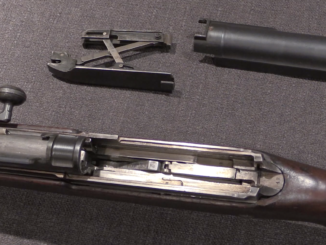When the French Army adopted the Mle 1892 revolver, it was a huge improvement over the previous standard from 1873. The new sidearm has a swing-out cylinder, simultaneous ejection, was lighter, and used a high-tech new small bore smokeless powder cartridge. With Army adoption came a tremendous interest for the civilian sector. Civilians heading off to live in the French colonies in Africa and Indochina, military officers and reservists, police agencies, and private security firms were all hot to get the fancy new weapon – rather like the civilian interest in the US Army’s new M17/SIG 320 handgun.
Civilian manufacture and sale began almost immediately, and in total about 88,000 civilian versions of the Mle 1892 were made (alongside 366,000 military ones). Copies were made in Spain and Belgium as well as within France itself. This example was proofed at the St Etienne proof house and sold by Manufrance – although it may well have been assembled from Belgian-made parts to reduce cost.




So what caliber is it chambered for?
The same 11mm only using smokeless?
Mle 92 consumes so-called 8mm French Ordnance cartridge according to https://www.militaryfactory.com/smallarms/detail.php?smallarms_id=320 however it can also accept older 8mm non réglementaire cartridge, see left quarter of 5th image from top here https://www.revolver1873.fr/cartouche-8-mm-non-reglementaire-revolver-1887.php
“A mechanically tight and very well finished handgun, the Modèle 1892 fires 8mm rounds with a striking power equivalent to that of a .32 ACP round. It also features a smaller calibre than many other military revolvers of that time period, including the Webley revolver and its predecessor the MAS 1873 revolver.”
Case type rimmed, straight
Bullet diameter 8.35 mm (0.329 in)[1]
Neck diameter 8.83 mm (0.348 in)[1]
Base diameter 8.96 mm (0.353 in)[1]
Rim diameter 10.43 mm (0.411 in)[1]
Rim thickness 1.35 mm (0.053 in)[1]
Case length 27.5 mm (1.08 in)[1]
Overall length 36.7 mm (1.44 in)[1]
Filling 0.79 g (12.2 gr) of black powder, later 0.3 g (4.6 gr) of Poudre B
Ballistic performance
Bullet mass/type Velocity Energy
7.8 g (120 gr) 225 m/s (740 ft/s) 196 J (145 ft⋅lbf)
1) I thought it was illegal for civilians to own a weapon that fired military ammunition in France. When did the law change?
2) Why not just mold the firining pin into the hammer? Were broken firing pins that common?
It is for a straight punch onto the primer, instead of arched…
Colonel:
Apparently it is not “illegal” to own a military calibre gun in France. In Italy, it may have been, hence the slightly modified 9mm pistol rounds used there (20mm rather than 19mm cases).
In France, as in most of Europe, there was freedom to own arms before the First World War. That was the war that changed everything. Some countries became dictatorships, and the ones which did not feared revolution, and so decided to disarm the people.
As far as I know, JohnK’s answer applies to today’s situation, but not to the conditions in France over most of the 20th century. Posession of a rifle in a military calibre was definitely illegal in France.
Alas, I could not find reliable data regarding handguns.
On the other hand, when France was in charge of German gun laws after WW1 (impersonated by the International Military Control Commission), 8 mm and above handguns were definitely considered war material and therefore illegal in Germany.
JP:
I think we need to define “illegal”. For most of the 20th Century, French gun laws were not too restrictive. Hunting rifles were on open sale, and I think these were of “civilian” calibre. When the FAMAS was adopted, a semi-auto version was made in .222 Remington for the civilian market. Military calibre rifles were not on open sale, but this did not mean they could not be owned, but only with the approval of the local prefect.
It’s all different now of course. The French have recently had one of those “amnesties”, whereby the peasants are encouraged to surrender their old shotguns and rifles to the state. Much safer they will all be, I am so sure.
The French ban post WWI on any pistol of 8mm or over in Germany also made so much sense. The fact that the vast majority of pistols owned by Germans were 7.65mm or 6.35mm cannot have been taken into account. So much gun control legislation exhibits similar rationality and common sense.
Col. 2) cheaper than hardening the entire part?
The parts are interchangeable between military and civilian versions?
How the exact dimensions and tolerances were obtained by Manufrance?
What did the French authorities say about copying their latest military revolver?
These guns, while ‘mass-produced’ in handgun terms, are not ‘interchangeable,’ nor produced by the millions using precision tools and gauged tolerances. The internal parts are hand-fitted, rather sloppy by modern standards, and may vary widely from gun to gun and manufacturer to manufacturer, even between French armories. This is not to say that the guns are poorly made; Up until the advent of MIM internals, virtually EVERY revolver was hand-fitted to varying degrees.
Contrarily, in the case of mass-produced military rifles, interchangeability WAS achieved, but at considerable cost, through accurate machine settings and rigid use of uniform gauging.